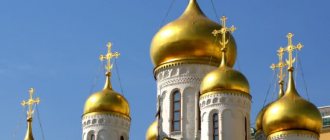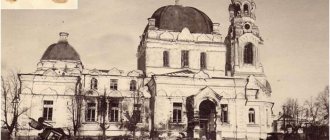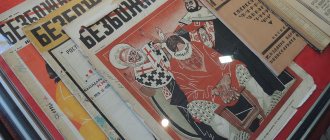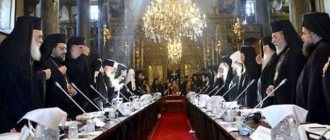III. Church governing bodies
In 1589, under Tsar Theodore Ioannovich, through the efforts of the boyar Boris Godunov, the Patriarchate was established in Rus'. The first Moscow Patriarch, Saint Job, was installed with the participation of the Ecumenical Patriarch Jeremiah II, who was then in Russia to collect alms. In connection with this act, a “Laid Charter” was drawn up, which is placed at the beginning of the “Helmsman’s Book”.
The “Laid Charter on the Establishment of the Moscow Patriarchate” is one of the most important documents in the history of the Russian Church, the Russian state, as well as in the sphere of relations between the Local Orthodox Churches. The reflection in its text of the idea of Elder Philotheus about the Third Rome also gives it the character of a monument of political, legal and theological thought.
At the same time, of particular importance is the fact that it bears the signatures of not only Russian bishops, archimandrites and abbots, but also the signature of the Patriarch of Constantinople Jeremiah, which stands in the first place, along with the signatures of Metropolitan Hierotheus of Monemvasia, Archbishop Arsenios of Elasson and the Greek Archimandrite Christopher. From the formal legal side, the “Laid Charter” is therefore a document that belongs equally to both Moscow and Constantinople. True, from the point of view of the creation of this text, it is a product of the royal office. Patriarch Jeremiah and the Greek bishops put their signatures on the document, to put it mildly, without enthusiasm. Metropolitan Hierotheus of Monemvasia did not want to sign the “Laid Charter” for a long time. “What kind of certificate is this? - he interrogated clerk A. Shchelkalov. “And what should I sign in it?” Shchelkalov explained: “It is written here how you installed the Patriarch and how you came here.” - “Then why not write it in Greek and why not let it be heard first?..” Hierotheus did not sign for a long time, saying that he feared that the Church of God would be divided and another chapter would appear in it and something would happen great schism. Hierotheus admits that, in the end, he signed the letter only out of fear that he would not be drowned in the Moscow River. Apparently, the royal bailiffs intimidated Hierotheus as a disobedient to the royal will. Jeremiah had to intercede for him and even, to calm his friend’s conscience, he performed a ritual of casting a spell on the Russians if they committed the schism that Hierotheus feared290. This is how the circumstances of the signing of the “Certificate” look like in the view of the famous Russian historian A.V. Kartashev, obviously quite reliable.
These curious circumstances associated with putting signatures on the document undoubtedly indicate hesitation on the part of the Greek bishops. Nevertheless, they nevertheless signed the “Laid in Letter”, which means that although it may have contained expressions that were inconvenient for them, there were none that were completely unacceptable. It would still be absurd to assume that the very contents of the “Laid Charter” were not known to the Greeks. In any case, we have reason, under all the peculiar circumstances of the preparation of the “Charter,” to consider it as an agreed document.
There is a place in the “Laid Letter” in which Elder Philotheus’s idea about the Third Rome is reproduced. This place was at one time the subject of both textual and substantive research by N.V. Sinitsina291. And the conclusions she made are, in general, adequate. It seems, however, appropriate to place special emphasis on the theological and canonical aspects of the problem. The following speech is put into the mouth of the Patriarch of New Rome in the “Laid Charter”: “In truth, the Holy Spirit abides in you, the pious king (meaning Theodore, the son of Ivan the Terrible, who then occupied the royal throne. - V. Ts.), and from God your thought will be translated into action (we are talking about the establishment of the Patriarchate in Moscow. - V. Ts.) rightly and truly your noble undertaking, and our humility and the entire Consecrated Council will accomplish that great work. Since the old Rome fell through the Apolinarian heresy, the second Rome, which is Constantinople, has the Hagarian grandsons from the godless Turks, but yours, O pious king, the great Russian kingdom, the third Rome, surpasses all in piety, and all the pious kingdoms have gathered into yours, and you are the only Christian king under heaven who is called throughout the universe, in all Christians, and by God’s Providence and the Most Pure Mother of God’s mercy and prayers for the sake of the new miracle workers of the great Russian kingdom Peter, and Alexy, and Jonah, and by your royal request from God, your royal advice, this is a great task for the performer.”292
Let’s compare this passage with Elder Philotheus’s own words according to the most authentic text, undoubtedly the original letter to the sovereign’s clerk Mikhail Grigorievich Misyura-Munekhin: “Yes, O Christ-loving and God-loving one, consider that the entire Christian kingdom has come to an end and has descended into the one kingdom of our sovereign, according to prophetic books, that is, the Roman kingdom. Two of Rome have fallen, and the third stands, and the fourth will not exist.”293
The main difference between the formula contained in the “Laid Charter” and the corresponding passage from the message of Elder Philotheus is, undoubtedly, the absence in the “Charter” of a prophetic statement that there will not be a fourth Rome. It is now difficult for us to say how, in the process of drawing up the document, this idea of Philotheus ended up being excluded from the “Laid Down Charter”: was it done at the request of the Greek side or was it decided in the very office that produced the document, because it was foreseen that the Greeks would not agree to inclusion in the text this document, so demanding and, on the basis of dogmas and canons, the elder’s unprovable thought, or the prophecy that Moscow is the last Rome and there will never be a fourth, was recognized by the compilers of the “Charter” in Moscow as inappropriate in an official church document, related to the relationship between the two Local Churches. The elimination of this formula deprives the document in question of its apocalyptic sharpness and eschatological perspective, so important for Elder Philotheus himself and, undoubtedly, muted in the later understanding of Philotheus’s ideas, when, however, the idea that there would be no fourth Rome became very popular and common, but , having lost Filofeev’s apocalyptic pathos, acquired a triumphalist sound.
Be that as it may, it is precisely the absence of this essential element from the ideological structure of Elder Philotheus in the “Laid-up Charter” that testifies to the critical approach of its compilers to the ideas borrowed from Philotheus, and therefore allows us to more thoroughly accept the words included in the “Charter”, as an expression of a coordinated position officially adopted by the hierarchs of not only the Russian, but also the Constantinople Church.
What meaning could the publishers of the “Charter” put into the formula about Moscow – the third Rome? To answer this question, one should read more carefully into the text of Elder Philotheus in order to offer an adequate interpretation of his statements about the fall of the first and new Rome. The first Rome, according to Philotheus, fell due to the heresy of Apollinaris. There is no mention of it in the above quotation, but it is spoken of elsewhere in the message. Connecting this heresy with the peculiarities of the Roman Catholic dogma is incorrect from a historical and dogmatic point of view: the Roman Church undoubtedly rejects and has always rejected the heresy of Apollinaris, in the exposition of which Elder Philotheus also cites the judgments of the extreme monophysite Eutyches, appropriating them to Apollinaris, to which the Roman The church, of course, never had anything to do with it. The elder connects Apollinaria with the teachings of the Roman Church through unleavened bread, the use of which in the Sacrament of the Eucharist in the Roman Church was the subject of particularly heated controversy between the Christian East and the Christian West, but, mainly, in that era when canonical communication between Old and New Rome was still preserved, obscuring the theologically more significant, completely dogmatic question of the filioque. In our context, Philotheus’ historical and dogmatic incorrectness is not relevant, because he is not interested in the dogmatic question in itself; it was only important for him to state that there is an element of heresy in the doctrine of the Roman Church. Consequently, Moscow, in this context the Russian Church, has preserved the Orthodox teaching handed down from the Apostles and Fathers in intact purity.
The fall of the second, New Rome is explained by Philotheus in a different way, without any relation to dogmatic issues. Although after the Council of Florence and the conquest of Constantinople by the Turks in Moscow there were suspicions about the purity of Orthodoxy among the Greeks, which later became one of the main, if not the main reason for the Old Believer schism, these suspicions, naturally, could not be reflected in the “Laid Charter”. N.V. Sinitsyna wrote about this: “The most significant characteristic feature of the concept of “Third Rome” as part of the charter of 1589 is its significant weakening (that is, the concept of an anti-Greek orientation), and this is quite understandable in the context of the charter with its appeal to the authority of the Sanctified Council of the “great Russian and Greek kingdoms”, “the entire Greek Council” and the Eastern Patriarchs”294. This statement is true only if we compare the idea of the Third Rome, as it is presented in the “Laid Charter”, with the fullness of the meanings that were put into it in various Russian monuments of an earlier era, but such a conclusion cannot be drawn on the basis of the text itself Elder Philotheus. In what he writes about the fall of Constantinople, it is impossible to detect an anti-Greek tendency: “Even though the walls and pillars and trench coats of the great Rome were not captured, but their souls were captured from the devil for the sake of unleavened bread. If the Agarins instilled the Greek kingdom without harming their faith, they would force the Greeks to retreat from the faith.”295 The anti-Latin passage is obvious, but there is nothing anti-Greek here; moreover, in this phrase one can also sense an element of some kind of benevolence towards the enslavers of the Greeks themselves, who do not force them to “apostate from the faith.”
In the message, however, there is something else: “Ninety years since the Greek kingdom was ruined and was not built up, this whole thing happened as a sin for our sakes, since they betrayed the Orthodox Greek faith in Latinism.”296 But, on the one hand, this accusation of betrayal of the faith, obviously, still applies not to all Greeks, but to the Uniate leaders of the Ferraro-Florence Council, and on the other hand, it is a reference to the sins of not only the Greeks, but “our sins” that is, all of us, speaks for itself. We are talking here about universal sinfulness, as the original cause of both personal troubles and social, historical catastrophes. The traitors to the Orthodox faith at the council in Florence were condemned by the Orthodox Greeks themselves - the followers of St. Mark of Ephesus; They could not deny the idea of universal sinfulness, so the Greeks should not have seen anything anti-Greek in the quoted words. Thus, the only meaning of the mention of the fall of the Second Rome both in Philotheus and in the “Laid Charter” is to state the fact of the conquest of Constantinople by the Ottomans and, as a result of this conquest, the termination of the existence of the Orthodox empire on the Bosphorus. Consequently, Moscow, here no longer in the sense of the Russian Church, but of the Russian kingdom, has become the Third Rome because it is an Orthodox state independent of the authorities of other faiths.
But this, of course, is not all that we can glean from the idea of the Third Rome, as it is expressed both in the messages of the elder and in the “Laid Charter” on the establishment of the patriarchate. Indirectly, the very naming of Moscow as the Third Rome already contains the idea that Rome is imperishable and in this sense eternal, for after the fall of one Rome another arises, or, better said, the same Rome, but in a different place. In his letter to Misyura Munekhin, Philotheus provides the following justification for the idea of the eternity of Rome: “Otherwise, the Roman kingdom is indestructible, as the Lord has written into Roman power”297 - an argument that is dogmatically acceptable only if the Roman kingdom means the Church of Christ. But these words obviously contain a different, more literal and historiosophical meaning, which, of course, cannot be justified by a dogmatically presented biblical argument.
In conjunction with the idea of the indestructibility of the Roman kingdom is the idea of the fundamental uniqueness, the uniqueness of Rome. Elder Philotheus writes to the sovereign’s clerk: “The entire Christian kingdom has come to an end and has descended into the one kingdom of our sovereign”298, and in the “Laid Charter” we find, in essence, an expanded paraphrase of the same thought: “Yours, O pious Tsar, the great Russian kingdom, the third Rome, surpassing all in piety, and all the pious kingdoms have gathered into yours, and you are the only Christian king under heaven who is called throughout the entire universe.”299
Thus, summarizing what has been said, we can conclude: the idea of the succession of Moscow to New Rome, present in the “Laid Charter,” includes the idea that Russia is an Orthodox autocratic state and that the political center of the Orthodox world is Moscow.
In May 1590, Patriarch Jeremiah convened a Council in Constantinople, in which Patriarch Joachim of Antioch and Sophronius of Jerusalem participated. Having told the assembled hierarchs about the wealth and greatness of the Moscow churches, the generosity and piety of the Russian Tsar and about the Tsar’s request to establish the Russian Patriarchate, he asked the council to approve his “chrisovull” - “The laid down document on the installation of a Patriarch in Moscow.” The Eastern Patriarchs recognized this matter as “gracious and blessed” and adopted a resolution: “First, we recognize and confirm the installation of Patriarch Job in the reigning city of Moscow, may he continue to be honored and named with us - the Patriarchs, and there will be a rank for him in prayers after Jerusalem ; and at the head and beginning he should hold the Apostolic Throne of Constantinograd, as other Patriarchs hold; secondly, the Patriarchal name and honor has now been given and approved not only to Mr. Job, but we decree that the Moscow Council will appoint Patriarchs in Russia according to the rules, as began from this fellow servant of our humility and in the Holy Spirit of our beloved brother Job. For this reason, this document was approved as a keepsake forever, in the summer of 1590, in the month of May.”300 The “Charter” was signed by the Patriarchs of Constantinople, Antioch, Jerusalem (the See of Alexandria was then widowed) and 42 metropolitans, 19 archbishops and 20 bishops who participated in the actions of the council.
In the conciliar act, the Russian sovereign is called “the only tsar on earth now, the great Orthodox,” but there is no mention of the Third Rome in this act. The reasons for this could be different. But among them, undoubtedly, was the fact that at this Council the question was not about the kingdom, but a purely ecclesiastical one, and, in particular, about the diptych. The Eastern Patriarchs did not want to place the Patriarch of Moscow in the diptych in front of themselves, following the Patriarch of Constantinople, as they had hoped for in Moscow. The Moscow Patriarch was given fifth place in the diptych, after the Eastern Patriarchs. Meanwhile, according to the 3rd canon of the Second Ecumenical Council, “Let the bishop of Constantinople have the advantage of honor over the bishop of Rome, because that city is New Rome.” If Moscow at the Council in Constantinople had been officially recognized by the Eastern Patriarchs as the Third Rome, then if we follow the logic of the fathers of the Second Ecumenical Council, and it would be natural to follow it, the Third Rome should have been given a place in the diptych immediately after the New Rome, that is, the second, and not at all the fifth. They did not want to do this, although at the same time they observed appropriate delicacy in relation to the Russian Tsar, the patron and protector of the Orthodox in the East. He was recognized as the only Orthodox Tsar, but Moscow was not called the Third Rome in order to place its Patriarchal Throne after all the Eastern ones. In Moscow, they were not happy with this decision about the place of the Russian Church in the Orthodox diptych, but they came to terms with it.
What does the term “autocephaly” mean?
Before talking about what an autocephalous Orthodox Church means, we should consider the term “autocephaly” itself. It comes from a Greek word consisting of two roots. The first of them is translated as “himself”, and the second is “head”. It is not difficult to guess that their combined use can mean “self-leadership,” which implies the most complete control of the entire internal life of the church and its administrative independence. In this way, autocephalous churches differ from autonomous churches, which are subject to certain legal restrictions.
The universal church is divided into local (autocephalous) churches not on a national basis, but on a territorial basis. This division is based on the words of the Apostle Paul that in Christ there is no division of people either by nationality or by their social status. All people constitute one “flock of God” and have one Shepherd. In addition, an undeniable convenience is the territorial correspondence of autocephalous churches to the political and administrative borders of states.
Autonomous churches and their features
Here it is appropriate to dwell on the state of affairs that developed before 1548, that is, until the moment when the Russian Orthodox Church became autocephalous. Its status in those centuries can be characterized as follows: an autonomous church. It was mentioned above that the main feature of autonomous churches is the lack of the right to independently elect their primate, whom the mother church supplies to them. This significantly limits their independence. And another important aspect of the issue is that the internal and sometimes foreign policy of their states largely depends on who heads the autocephalous independent Orthodox churches.
In fairness, it should be noted that even before Metropolitan Jonah received the title of Metropolitan of Moscow and All Rus', the dependence of the Russians on Constantinople was not too burdensome. The geographic distance from Byzantium, our mother church, played a role here. The churches formed in the territories of the Greek metropolises were in a much worse situation.
Restrictions placed on the rights of autocephalous churches
Restrictions on the rights of local churches are determined by the principle of church unity. Based on it, all autocephalous churches are identical with each other and are separated only territorially, but not dogmatically or by differences in matters of doctrine. The fundamental principle is the right of the Universal Church alone to interpret religious dogmas, while leaving unchanged the essence of the Orthodox faith.
In addition, the resolution of the most important canonical issues goes beyond the legal framework of local churches and is the responsibility of the Ecumenical Councils. Also, the construction of liturgical life within autocephaly must be generally accepted and be in accordance with the guidelines adopted by the Ecumenical Councils.
Unauthorized establishment of autocephaly
However, history knows many cases of violations of these established rules. Sometimes state authorities declared the churches of their countries autocephalous, and sometimes local episcopates voluntarily withdrew from subordination to the highest authorities and, having elected a primate, declared independence. It should be noted that in most cases there were objective reasons for such actions.
Subsequently, their canonical illegality was corrected by completely legitimate acts, although adopted with some delay. As an example, we can recall the unauthorized separation of the Polish autokyphalists from the Russian Mother Church in 1923. The legality of this act was restored only in 1948, when the church became legally autocephalous. And there are many similar examples.
Currently existing autocephalous churches of Orthodoxy
There are currently fifteen autocephalous churches. All of them are Orthodox, so the frequently asked question about how the autocephalous Church differs from the Orthodox Church naturally disappears by itself. It is customary to list them in the order of a diptych—remembrance at the liturgy.
The first nine are ruled by patriarchs. Among them are the Constantinople, Alexandria, Antioch, Jerusalem, Russian, Georgian, Serbian, Romanian and Bulgarian churches. Following them come those headed by archbishops. These are Cypriot, Hellenic and Albanian. The list of churches that are governed by metropolitans is completed: the Polish, Czech lands and Slovakia, the Orthodox Autocephalous Church in America.
The fifth Russian Church on the list above became autocephalous in 1589. It received its status from the Patriarchate of Constantinople, from which it was dependent until 1548, when a council of Russian bishops elected Metropolitan Jonah as head of the church. The further growing economic and military power of Russia contributed to the strengthening of the political, military and religious authority of our country. As a result, the eastern patriarchates recognized Russia as the fifth “honorable” place.
Significant restrictions on the freedom of autonomous churches
Autonomous churches, in addition to being governed by a primate appointed by the mother church, were obliged to coordinate their charters, statuses with it, and consult on all any serious issues. They did not have the right to consecrate the ointment on their own. Their bishops were subject to the jurisdiction of the highest court - the court of the kyriarchal church, and they had the right to build their relations with others only through the mother church. All this gave rise to organizational difficulties and hurt national pride.
Intermediate nature of autonomy status
History shows that the status of autonomy of churches is usually temporary, interim. As a rule, over time, they either become autocephalous local Orthodox churches, or, having lost even the appearance of independence, they are transformed into ordinary metropolitan districts or dioceses. There are many examples of this.
Today, three autonomous churches are commemorated in liturgical diptychs. The first of them is the ancient Sinai. It is governed by a bishop appointed from Jerusalem. Next comes the Church of Finland. For her, the Mother Church became the Autocephaly of Constantinople. And finally, the Japanese, for which the Russian Orthodox Church is kyriarchal. The light of Orthodoxy was brought to the islands of Japan at the beginning of the last century by a Russian missionary, Bishop Nikolai (Kasatkin), who was later canonized. For his services to the church, he was awarded the honor of being called Equal-to-the-Apostles. Such a title is given only to those who brought Christ’s teaching to entire nations.
All these churches are Orthodox. As absurd as it is to look for the difference between the autocephalous church and the Orthodox, it is so absurd to talk about the difference between the autonomous and the Orthodox. The need for such an explanation is caused by frequently asked questions about this.
Rights of autocephalous churches
In order to most fully characterize the essence of autocephaly, it is necessary to take a closer look at the rights that autocephalous churches have. The most important of these is the right to appoint and elect the head of the church by its own bishops. To do this, there is no need to coordinate this or that candidacy with the leaders of other local churches. This is the main difference between autocephalous and autonomous churches. The latter are headed by primates appointed by the church that granted them autonomy.
In addition, local churches have the right to independently issue their own charters. They operate, of course, only in the territory controlled by a given church. Issues related to the structure and management of the church are also resolved internally. The most important of them are submitted to local councils for consideration.
Autocephalous churches have the right to independently consecrate the holy chrism intended for use within the church. Another important right is the possibility of canonizing one’s own saints and drawing up new liturgical rites and chants. The last point has only one caveat - they should not go beyond the framework of dogmatic teachings accepted by the Universal Church.
Local churches are given complete independence in resolving all administrative issues. The same applies to the church court, the right to convene local councils and the possibility of initiating the convening of an Ecumenical Council.







